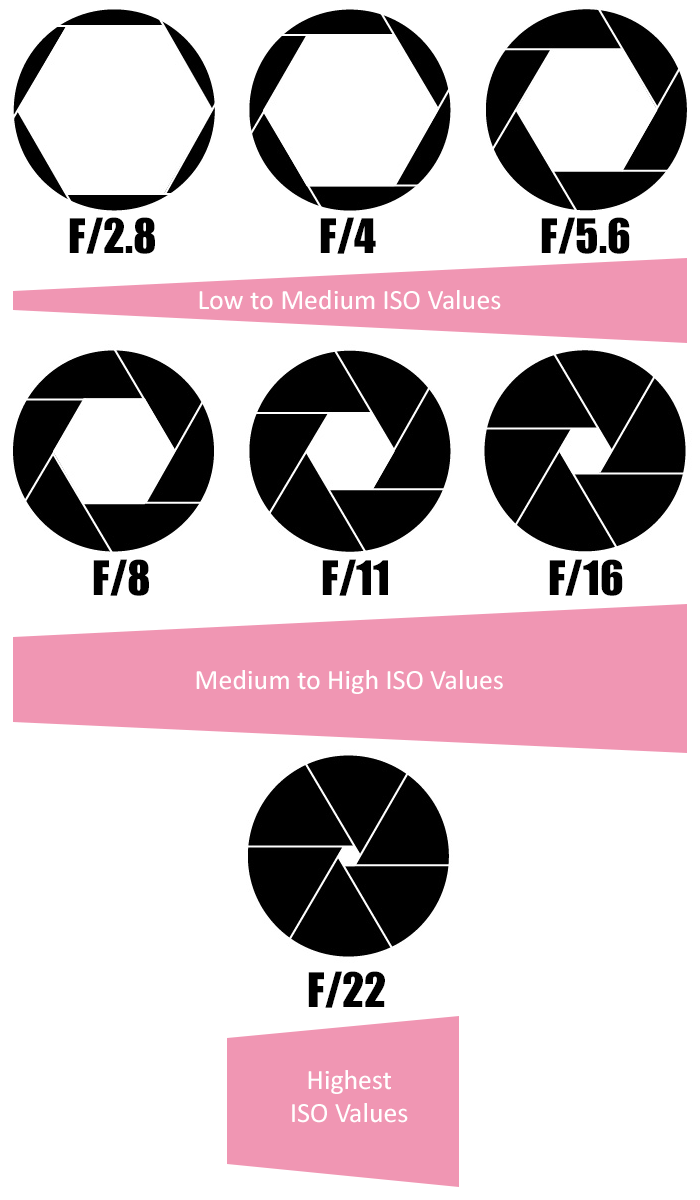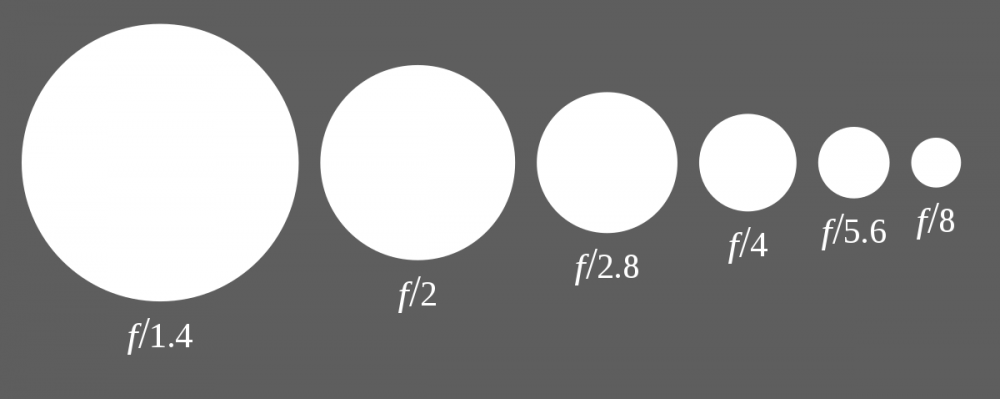CampFireJack
Member
- Joined
- May 9, 2021
- Messages
- 118
- Reaction Score
- 1
- Points
- 16
- #1
We all know that lower ISO values are better when it comes to photography. High ISO adds grain to an image, so it’s only logical that the lower you go, the better things are. The thing is, it’s not always clear to many new and budding photographers how the different settings on a camera can affect this value. Just so you know, the three big settings are shutter speed, aperture and ISO. It’s the dance between these three that can give you the results you’re after.
I want to talk about two things in this post today. I’d like to first discuss something pretty neat that not many of us pay attention to when we’re out and about taking photographs and purchasing lenses. That’s basically how the different aperture sizes compare to one another. I find this topic so cool and I always love looking at how much larger an F/2.8 is than an F/4. It’s crazy and this is “need to know” information when buying a new lens for your camera.
The next topic I’d like to discuss is an easy one. I’d like to reiterate the importance of knowing how your camera settings can affect your photographs. In today’s post, I’m going to limit the discussion to aperture versus ISO values. I’m not going to bring in depth of field at all. I’ve covered that in the past and I’m sure I’ll cover it in the future. For today though, I simply want to talk about light and sensor sensitivity.
Before I begin though, I’d like to bring attention to a very neat graphic I just finished making in Adobe Photoshop. I hope you like it. I’l be referring to it quite a bit in this post.

If you take a glance at the graphic above, you’ll see how different aperture sizes truly are. At the top left, we have an F/2.8 and down at the bottom, we’ve got an F/22. The white hole at the center of the circle is the actual opening that will allow light to pass through the lens. Think about a lens as a straw. A wide straw will let you finish your soda in a few seconds while a thin straw will force you to take more time to finish the same soda. Big apertures let tons of light through. This is perfect for low light and night time photography because you’ll need all the light you can get. Daytime photography, well…I discussed that above. Sometimes too much light can be a bad thing.
The primary area I’d like to focus on in this section is how much the aperture size grows as you go down in number. I used to think like, “I mean really. How much different can an F/2.8 aperture be from an F/4 one? Those numbers are so close in the grand scheme of things.” Well, take a look at the graphic above. I’m no mathematician, but I can tell you that the F/2.8 lens lets in about twice the amount of light that the F/4 lens lets in. It doesn’t look like that, but the area of something can be deceiving in these types of comparisons. So if you were shopping for a lens to use at night, you would certainly go for the lowest number possible.
I know my graphic only goes down to F/2.8. Check out how large apertures get when they go down to F/1.4. Huge!

So yeah, these things make a big difference. I just wanted to impress that upon you as much as possible.
Here’s the relationship between aperture and ISO values; the larger the aperture, the less of an increase in ISO the camera will need. As you open your lens farther and farther, the lower the ISO value will fall. It’s that simple. I attempted to illustrate that in my graphic above. If you shrink the aperture, your camera isn’t going to have much of a choice other than to increase the ISO, given that the shutter speed is locked in at a specific setting and it’s not super slow.
I guess there’s not much more to say about this. I hope you got something out of it. I know it’s important to repeat these principles a few times because folks tend to forget them. Also, if you like the graphic I created, feel free to share this page around. Perhaps other will like it too.
If you have any questions regarding this post, please ask down below or in the photography discussion forum. I’m always here to help. Thanks for reading!
I want to talk about two things in this post today. I’d like to first discuss something pretty neat that not many of us pay attention to when we’re out and about taking photographs and purchasing lenses. That’s basically how the different aperture sizes compare to one another. I find this topic so cool and I always love looking at how much larger an F/2.8 is than an F/4. It’s crazy and this is “need to know” information when buying a new lens for your camera.
The next topic I’d like to discuss is an easy one. I’d like to reiterate the importance of knowing how your camera settings can affect your photographs. In today’s post, I’m going to limit the discussion to aperture versus ISO values. I’m not going to bring in depth of field at all. I’ve covered that in the past and I’m sure I’ll cover it in the future. For today though, I simply want to talk about light and sensor sensitivity.
Before I begin though, I’d like to bring attention to a very neat graphic I just finished making in Adobe Photoshop. I hope you like it. I’l be referring to it quite a bit in this post.

A Look at the Different Aperture Sizes
So here’s the thing. When you’re out shopping for a new camera lens, you need to be very mindful of what you’ll be using that lens for. I can remember back when I purchased my first new lens, which was years ago, by this point. I really didn’t know what I was looking for and my primary source for deciding if I wanted a particular lens or not came from star ratings. If a lens was rated highly, I guessed it would be good for me. Today, I’m much wiser than that and I now know that different lenses are used for different things. If I want shallow depth of field and something that’s good in low light, I would most likely go with a prime lens that offers a large aperture. If I was going to use the lens for landscape photography on bright sunny days, I would definitely think about a lens that offers a smaller aperture because it would have a deeper depth of field and it would keep some of the light out of the camera. If there was too much light, the resulting photo might come out over-exposed and I’d likely need to use a lens filter to combat that. My point here is, be sure you know what you’re looking at when you’re ready to buy.If you take a glance at the graphic above, you’ll see how different aperture sizes truly are. At the top left, we have an F/2.8 and down at the bottom, we’ve got an F/22. The white hole at the center of the circle is the actual opening that will allow light to pass through the lens. Think about a lens as a straw. A wide straw will let you finish your soda in a few seconds while a thin straw will force you to take more time to finish the same soda. Big apertures let tons of light through. This is perfect for low light and night time photography because you’ll need all the light you can get. Daytime photography, well…I discussed that above. Sometimes too much light can be a bad thing.
The primary area I’d like to focus on in this section is how much the aperture size grows as you go down in number. I used to think like, “I mean really. How much different can an F/2.8 aperture be from an F/4 one? Those numbers are so close in the grand scheme of things.” Well, take a look at the graphic above. I’m no mathematician, but I can tell you that the F/2.8 lens lets in about twice the amount of light that the F/4 lens lets in. It doesn’t look like that, but the area of something can be deceiving in these types of comparisons. So if you were shopping for a lens to use at night, you would certainly go for the lowest number possible.
I know my graphic only goes down to F/2.8. Check out how large apertures get when they go down to F/1.4. Huge!

So yeah, these things make a big difference. I just wanted to impress that upon you as much as possible.
The Relationship Between Aperture Size & ISO
Let me ask you a question. Do you think using an ISO value of 6400 is a good thing? Do you think that ISO value would introduce noise or grain into an image? The answer is that it’s not a good thing and yes, it would likely introduce noise into an image. If you were taking photos of a birthday party at night and the scene was dark, you would definitely want to do everything in your power to keep the ISO value down. Your camera will want to pop it up as high as possible because that’s what cameras do. They don’t know any better. So basically, your options are to lower the ISO value manually and use a slow shutter speed or to lower it down and use a large aperture. Since there are moving subjects in a birthday photograph, slow shutter speeds aren’t really an option. The only other option you’ve got is to open up that aperture as wide as possible.Here’s the relationship between aperture and ISO values; the larger the aperture, the less of an increase in ISO the camera will need. As you open your lens farther and farther, the lower the ISO value will fall. It’s that simple. I attempted to illustrate that in my graphic above. If you shrink the aperture, your camera isn’t going to have much of a choice other than to increase the ISO, given that the shutter speed is locked in at a specific setting and it’s not super slow.
I guess there’s not much more to say about this. I hope you got something out of it. I know it’s important to repeat these principles a few times because folks tend to forget them. Also, if you like the graphic I created, feel free to share this page around. Perhaps other will like it too.
If you have any questions regarding this post, please ask down below or in the photography discussion forum. I’m always here to help. Thanks for reading!
